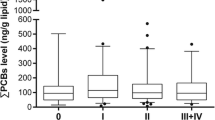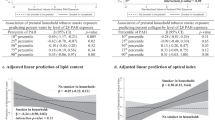Abstract
We conducted a case–control study to evaluate the risk of breast cancer associated with adipose concentrations of polybrominated diphenyl ethers (PBDEs) among women undergoing surgical breast biopsies in the San Francisco Bay Area of California (n = 78 cases; 56 controls). Adipose tissue was analyzed for the five major congeners of PBDEs. Unconditional logistic regression was used to estimate age- and race-adjusted exposure-specific odds ratios (ORs) and 95% confidence intervals (95% CI). Adipose levels of PBDEs were among the highest ever reported. Adjusted ORs for the highest compared with lowest levels of exposures were as follows: 0.56 (95% CI 0.19–1.68) for BDE-47; 1.19 (95% CI 0.35–4.10) for BDE-99; 0.91 (95% CI 0.33–2.53) for BDE-100; 0.52 (95% CI 0.19–1.39) for BDE-153; 1.67 (95% CI 0.44–6.29) for BDE-154; 2.04 (95% CI 0.45–9.20) for total BDEs. These results provide no evidence of an association between PBDE adipose concentrations measured at or near the time of diagnosis and breast cancer risk. Our study was limited by a small sample size. Given the high levels of PBDEs found in this population of California women, future studies are warranted. Such studies would benefit from a larger sample size, a more representative control series, and/or a prospective design.

Similar content being viewed by others
References
Costa LG, Giordano G, Tagliaferri S, Caglieri A, Mutti A (2008) Polybrominated diphenyl ether (PBDE) flame retardants: environmental contamination, human body burden and potential adverse health effects. Acta Biomed 79(3):172–183
Darnerud PO (2008) Brominated flame retardants as possible endocrine disrupters. Int J Androl 31(2):152–160
Bradman A, Fenster L, Sjodin A, Jones RS, Patterson DG Jr., Eskenazi B (2007) Polybrominated diphenyl ether levels in the blood of pregnant women living in an agricultural community in California. Environ Health Perspect 115(1):71–74
Hites RA (2004) Polybrominated diphenyl ethers in the environment and in people: a meta-analysis of concentrations. Environ Sci Technol 38(4):945–956
Parkin DM, Whelan SL, Ferlay J, Raymond L, Young J (eds) (1997) Cancer incidence in five continents. International Agency for Research on Cancer (IARC), Lyon, France
Fischer D, Hooper K, Athanasiadou M, Athanassiadis I, Bergman A (2006) Children show highest levels of polybrominated diphenyl ethers in a California family of four: a case study. Environ Health Perspect 114(10):1581–1584
Petreas M, She J, Brown FR, Winkler J, Windham G, Rogers E, Zhao G, Bhatia R, Charles MJ (2003) High body burdens of 2, 2′,4,4′-tetrabromodiphenyl ether (BDE-47) in California women. Environ Health Perspect 111(9):1175–1179
Zota AR, Rudel RA, Morello-Frosch RA, Brody JG (2008) Elevated house dust and serum concentrations of PBDEs in California: unintended consequences of furniture flammability standards? Environ Sci Technol 42(21):8158–8164
Schecter A, Papke O, Tung KC, Joseph J, Harris TR, Dahlgren J (2005) Polybrominated diphenyl ether flame retardants in the U.S. population: current levels, temporal trends, and comparison with dioxins, dibenzofurans, and polychlorinated biphenyls. J Occup Environ Med 47(3):199–211
Legler J (2008) New insights into the endocrine disrupting effects of brominated flame retardants. Chemosphere 73(2):216–222
Meerts IA, Letcher RJ, Hoving S, Marsh G, Bergman A, Lemmen JG, van der Burg B, Brouwer A (2001) In vitro estrogenicity of polybrominated diphenyl ethers, hydroxylated PDBEs, and polybrominated bisphenol A compounds. Environ Health Perspect 109(4):399–407
Hamers T, Kamstra JH, Sonneveld E, Murk AJ, Kester MH, Andersson PL, Brouwer A (2006) In vitro profiling of the endocrine-disrupting potency of brominated flame retardants. Toxicol Sci 92(1):157–173
Reynolds P, Hurley SE, Petreas M, Goldberg DE, Smith D, Gilliss D, Mahoney ME, Jeffrey SS (2005) Adipose levels of dioxins and risk of breast cancer. Cancer Causes Control 16(5):525–535
Petreas M, Smith D, Hurley S, Jeffrey SS, Gilliss D, Reynolds P (2004) Distribution of persistent, lipid-soluble chemicals in breast and abdominal adipose tissues: lessons learned from a breast cancer study. Cancer Epidemiol Biomarkers Prev 13(3):416–424
Brown FR, Winkler J, Visita P, Park JS, Petreas M (2007) Simultaneous analysis of PCBs and polybrominated diphenyl ethers (PBDEs) in human adipose using GC/MS/MS. Organohalogen Compounds 69:1199–1202
SAS Institute I: SAS 9. In. 9 edn. Cary, NC: SAS Institute Inc.; 2007
R Development Core Team (2009) R: a language and environment for statistical computing, R foundation for statistical computing, Vienna, Austria
Sjodin A, Wong LY, Jones RS, Park A, Zhang Y, Hodge C, Dipietro E, McClure C, Turner W, Needham LL et al (2008) Serum concentrations of polybrominated diphenyl ethers (PBDEs) and polybrominated biphenyl (PBB) in the United States population: 2003–2004. Environ Sci Technol 42(4):1377–1384
Kabat GC, Jones JG, Olson N, Negassa A, Duggan C, Ginsberg M, Kandel RA, Glass AG, Rohan TE (2010) A multi-center prospective cohort study of benign breast disease and risk of subsequent breast cancer. Cancer Causes Control 21(6):821–828
Petreas M, Nelson D, Brown FR, Goldberg D, Hurley S, Reynolds P (2011) High concentrations of polybrominated diphenylethers (PBDEs) in breast adipose tissue of California women. Environ Int 37(1):190–197
Zhao G, Wang Z, Dong MH, Rao K, Luo J, Wang D, Zha J, Huang S, Xu Y, Ma M (2008) PBBs, PBDEs, and PCBs levels in hair of residents around e-waste disassembly sites in Zhejiang Province, China, and their potential sources. Sci Total Environ 397(1–3):46–57
Zhao G, Wang Z, Zhou H, Zhao Q (2009) Burdens of PBBs, PBDEs, and PCBs in tissues of the cancer patients in the e-waste disassembly sites in Zhejiang, China. Sci Total Environ 407(17):4831–4837
Hardell L, Lindstrom G, van Bavel B, Wingfors H, Sundelin E, Liljegren G (1998) Concentrations of the flame retardant 2,2′,4,4′-tetrabrominated diphenyl ether in human adipose tissue in Swedish persons and the risk for non-Hodgkin’s lymphoma. Oncol Res 10(8):429–432
Hardell L, Bavel B, Lindstrom G, Eriksson M, Carlberg M (2006) In utero exposure to persistent organic pollutants in relation to testicular cancer risk. Int J Androl 29(1):228–234
McDonald TA (2002) A perspective on the potential health risks of PBDEs. Chemosphere 46(5):745–755
Schmidt K (2004) Preventing fires, igniting questions. In: US News and World Report vol. 136, Washington; April 26: 70
Acknowledgments
This work was supported by the California Breast Cancer Research Program (Grants #2RB-0054 and 10IB-0061) and by the US Army Medical Research and Materiel Command (Grant #DAMD17-94-J-4429 P6003). The ideas and opinions expressed herein are those of the authors and endorsement by the Cancer Prevention Institute of California, Stanford University, or the California Department of Toxic Substances Control is not intended or should be inferred. The authors would like to thank all the women who participated in the study; Ms. M. Suzuki and Ms. A. Rothblatt who interviewed the women; Dr. Dawn LeManne who helped initiate the study; Drs. K. O’Neal, E. Mahoney, and L Bailey for assistance in recruiting patients; and Lynn Brissette and the other surgical staff who assisted in this effort.
Author information
Authors and Affiliations
Corresponding author
Rights and permissions
About this article
Cite this article
Hurley, S., Reynolds, P., Goldberg, D. et al. Adipose levels of polybrominated diphenyl ethers and risk of breast cancer. Breast Cancer Res Treat 129, 505–511 (2011). https://doi.org/10.1007/s10549-011-1481-7
Received:
Accepted:
Published:
Issue Date:
DOI: https://doi.org/10.1007/s10549-011-1481-7




